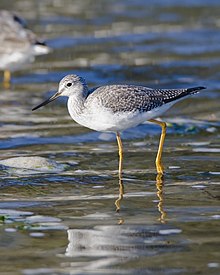Greater yellowlegs
| Greater yellowlegs | |
|---|---|

| |
| Scientific classification | |
| Domain: | Eukaryota |
| Kingdom: | Animalia |
| Phylum: | Chordata |
| Class: | Aves |
| Order: | Charadriiformes |
| Family: | Scolopacidae |
| Genus: | Tringa |
| Species: | T. melanoleuca
|
| Binomial name | |
| Tringa melanoleuca (Gmelin, JF, 1789)
| |

| |
Breeding Migration Nonbreeding
| |
| Synonyms | |
|
Totanus melanoleucus | |
The greater yellowlegs (Tringa melanoleuca) is a large
Taxonomy
The greater yellowlegs was
Description
The greater yellowlegs is similar in appearance to the smaller
, which is altogether more robustly built. The greater yellowlegs and the greenshank share a coarse, dark, and fairly crisp breast pattern as well as much black on the shoulders and back in breeding plumage.Adults have long yellow legs and a long, thin, dark bill which has a slight upward curve and is longer than the head. The body is grey-brown on top and white underneath; the neck and breast are streaked with dark brown. The rump is white. It ranges in length from 29 to 40 cm (11 to 16 in) and in weight from 111 to 250 g (3.9 to 8.8 oz). Wingspan is 23.6 in (60 cm).[9]
The call is harsher, louder, and clearer than that of the lesser yellowlegs. They have a three-syllable whistle when flight-calling, with a lower pitched third syllable.
Distribution and habitat
Their breeding habitat is bogs and marshes in the
Behavior and ecology

Breeding
They nest on the ground, usually in well-hidden locations near water. The three to four eggs average 49 mm (1.9 in) in length and 33 mm (1.3 in) in breadth and weigh about 28 g (0.99 oz). The incubation period is 23 days. The young leave the nest within 24 hours of hatching and then leave the vicinity of the nest within two days.[10]
Food and feeding

These birds forage in shallow water, sometimes using their bills to stir up the water. They mainly eat insects and small fish, as well as crustaceans, marine worms, frogs, seeds and berries.[10]
References
- . Retrieved 12 November 2021.
- ^ Gmelin, Johann Friedrich (1789). Systema naturae per regna tria naturae : secundum classes, ordines, genera, species, cum characteribus, differentiis, synonymis, locis (in Latin). Vol. 1, Part 2 (13th ed.). Lipsiae [Leipzig]: Georg. Emanuel. Beer. p. 659.
- ^ Latham, John (1785). A General Synopsis of Birds. Vol. 3, Part 1. London: Printed for Leigh and Sotheby. p. 152, No. 23.
- ^ Pennant, Thomas (1785). Arctic Zoology. Vol. 2. London: Printed by Henry Hughs. p. 468, No. 376.
- ^ Linnaeus, Carl (1758). Systema Naturae per regna tria naturae, secundum classes, ordines, genera, species, cum characteribus, differentiis, synonymis, locis (in Latin). Vol. 1 (10th ed.). Holmiae (Stockholm): Laurentii Salvii. p. 148.
- ^ Rasmussen, Pamela, eds. (August 2022). "Sandpipers, snipes, coursers". IOC World Bird List Version 12.2. International Ornithologists' Union. Retrieved 6 November 2022.
- ISBN 978-1-4081-2501-4.
- .
- ^ "Greater Yellowlegs Identification, All About Birds, Cornell Lab of Ornithology". www.allaboutbirds.org. Retrieved 2020-09-30.
- ^ . Retrieved 7 November 2022.

